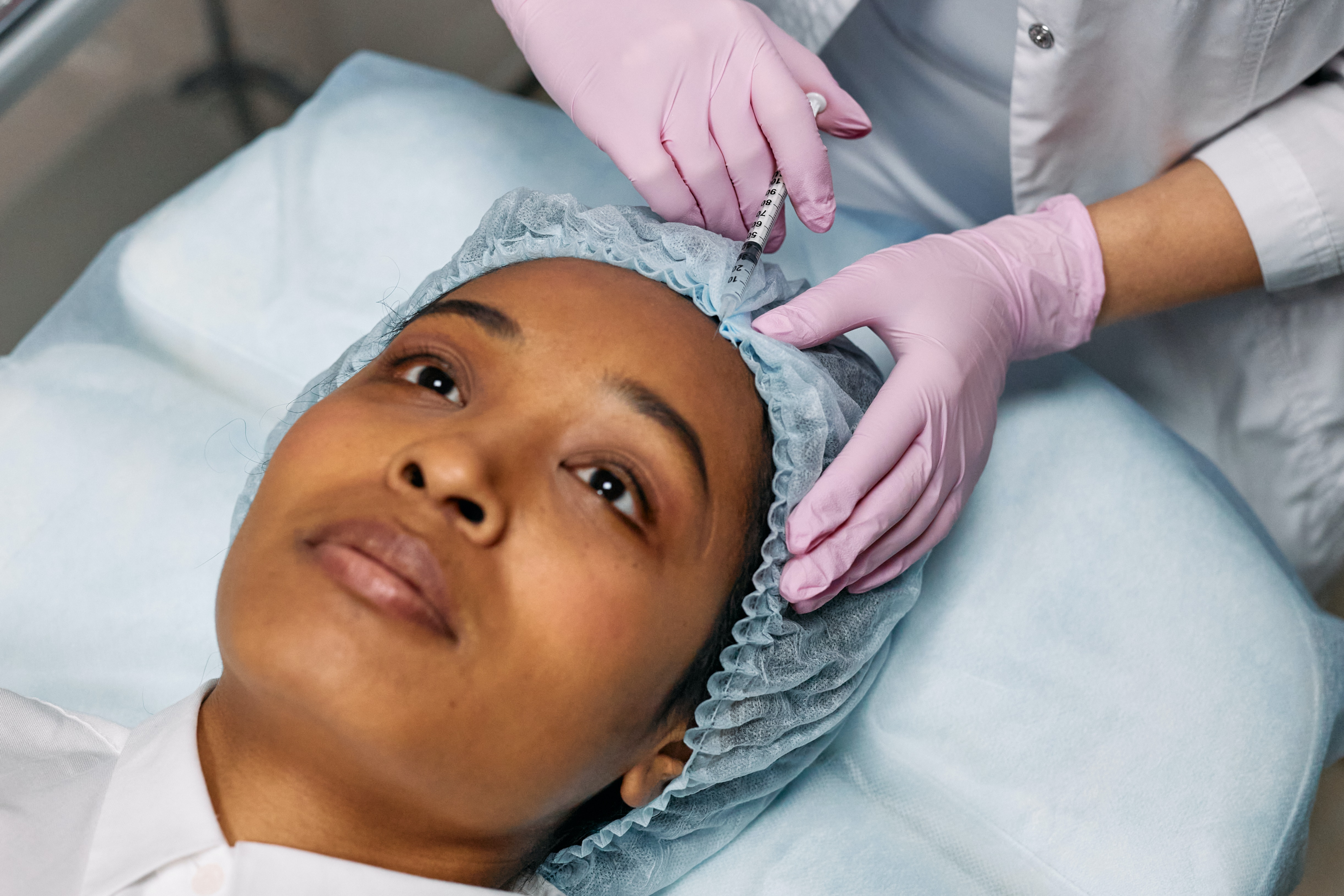What Do Dermatologists Prescribe For Hair Loss?
1st Feb 2023
Sometimes home remedies and over-the-counter products are not enough to help your thinning hair start growing again. If you need something more for your hair loss, you’ll need to go to a dermatologist’s office.
Before you go, you may want to know in advance just what a dermatologist may prescribe so you have some idea of what to expect. Their recommendation will depend on what is causing your hair loss, which a dermatologist will be able to tell you with a few tests.
What Causes Hair Loss
There are too many types of hair loss to list them all here. I’ll try to list the most common causes, which is what most patients will have. Some of these affect both men and women; others affect only women, such as postpartum hair loss.
Telogen Effluvium
This type of hair loss can be caused by many things. As its name implies, it happens in the telogen phase of your hair growth.
It is in this phase that your hair follicles are resting, but the hair shaft is supposed to stay firmly in the hair follicle. However, with telogen effluvium, the hair comes out sooner than it should and long before it starts growing again.
The most common cause is some type of stress. This can be a stressful event, such as getting into a car accident or a tight deadline at work.
It can also be caused by physical stress. This can be starting an intense new workout routine when you don’t usually exercise much, having a surgery or a severe illness your body has to recover from, or simply an underlying medical condition making it harder for your body to function properly.
Male Pattern Baldness
Male pattern hair loss is probably one of the most well-known causes of hair fall. Female pattern hair loss, though slightly less common, is still a problem for many women, and it is caused by the same thing.
The technical name for male and female pattern hair loss is androgenetic alopecia. Androgenetic alopecia is mostly caused by DHT, which is a by-product of testosterone.
However, not all testosterone turns into DHT, which is why androgenetic alopecia is considered to be a type of hereditary hair loss.
Hormonal Imbalances
Women experience hair loss because of this more often than men simply because there are more points in a woman’s life when her hormones change.
The most common causes for a hormonal imbalance in women are after having a baby (postpartum hair loss) and menopause.
However, some women experience hormonal changes when beginning or stopping birth control and even in small amounts with each menstrual cycle. Any one of these shifts in hormone levels can cause hair loss.
Fungal Infections
There are many funguses that can affect your scalp. Ringworm is a common type, as is dandruff, which is actually a type of yeast infection. Piedra and folliculitis are two other types that can also affect your hair health.
A Few Others To Mention
Underlying medical conditions, such as heart problems or high blood pressure, can cause hair loss. Anything that affects how your blood moves through your body has the potential to affect your hair growth.
Autoimmune disorders also cause hair thinning, whether or not they directly affect your scalp. Thyroid problems and other medical conditions can also harm your hair. Chemotherapy is well-known for causing rapid hair loss.

Finally, acne keloidalis, dissecting cellulitis, and folliculitis decalvans are all different hair loss conditions that involve some type of acne-like pustules. Each can cause scarring and permanent damage to your hair follicles.
How A Dermatologist May Diagnose Hair Loss
Your dermatologist may be able to tell just from a physical examination what is causing hair loss on your scalp. However, in some cases, tests are needed to determine the exact cause.
In order to choose what hair loss treatment is best, you’ll need to know what you are treating. This is especially true since some types of hair loss appear similar but require different treatments to fix.
Ask Questions
The first thing most dermatologists may do is ask questions about your hair growth. Before you arrive, you should be prepared to answer the following:
- When did you first notice hair thinning?
- Has your hair loss been quick or gradual?
- Are you having any other symptoms besides hair loss?
- Does hair loss run in your family history?
- Do you have any medical conditions that could be contributing to your hair loss?
- Are you currently taking any medications or supplements?
These and other questions can provide a dermatologist with more info and will give them somewhere to start.
Simple Tests
While doing your physical exam, the doctor will probably do a pull test. This is where they will lightly tug on a small section of hair to see how many hairs come out.
At the dermatologist’s office, they will certainly have a large magnifying glass specifically for examining your scalp. These help your doctor spot any velus hairs or see if it is hair breakage making your hair look thin.
They will also check for any redness, swelling, scarring, or any other visible things that might be causing hair loss.
Lab Tests
If there isn’t a reason they can identify that is causing your hair loss, they may have you do a blood test to search for any deficiencies. In cases of female hair loss, the blood test may also test your hormones to see if they are out of balance.
They may also do a swab of your scalp or take a hair sample to test for fungal growth if they think you have a type of fungal infection. This sample is then sent to a lab, which may take a few weeks to get the results back.
Finally, you may be asked to give a punch biopsy, which is where they ‘punch’ a small hole in your scalp to take a sample of your hair follicles and roots.
Sometimes a scalp biopsy is necessary if there are a few possibilities that have similar appearances but which need different treatments, such as cicatricial and scarring alopecia.

What Treatments Dermatologists Prescribe
There are many hair loss treatments that a dermatologist can prescribe that can help with hair loss. However, you might be surprised to know how few treatments are actually FDA-approved.
If your hair is likely to regrow on its own, you may be told to take specific supplements or to go on a certain diet. If you have vitamin deficiencies, you will, of course, be told to take a supplement to correct that.
In the meantime, if your hair falls out quickly or there is not a board-certified dermatologist with an open slot soon enough, they usually recommend that you invest in wigs or scarves if you are self-conscious about your hair loss.
Hair loss shampoos and other products can also help your hair strands to prevent further hair loss. This is besides hair masks, hair serums, and hair creams that your dermatologist might know of and recommend.
Minoxidil (Rogaine)
Minoxidil is a topical treatment for hair loss that is primarily either in a foam or liquid form, though it can be found in some shampoos as well.
Topical minoxidil is most commonly used to treat male pattern hair loss, but it is also used for alopecia areata, which is one of the autoimmune hair disorders. Its main focus is increasing blood flow to your scalp, which it can due thanks to being a vasodilator.
It also assists in blocking DHT to allow new hair growth in the areas where your hair follicle might have been strangled.
Though minoxidil doesn’t require a prescription, your dermatologist is able to help you determine the best concentration for you. They can also demonstrate the most effective way to apply it.
Finasteride is also a DHT blocker that can help with hair loss caused by androgenetic alopecia. Dutasteride, though less popular, may be recommended by your dermatologist.
Spironolactone is a treatment for hair loss in women caused by female pattern baldness. It is similar to topical minoxidil in that it helps block DHT from forming.
However, unlike minoxidil, it is also a ‘water pill.’ This means spironolactone prevents your body from absorbing excess water. It, as well as other antiandrogen medications, is available only as a prescription medication.
Laser Therapy
Low-level laser therapy can stimulate hair growth for some people, though it doesn’t work for everyone. Your doctor may have a laser in their office, or they may recommend you get one to do laser therapy at home.
It is thought that a laser treatment works by encouraging circulation and stimulating your scalp to achieve hair regrowth. This can be purchased as a Thermadome, a Lasercap, or some other form.
Hair Transplant Surgery
If you have scarring alopecia, there is no way to get your hair follicles growing again. The same is true if your follicles are completely dead. This is the case with some male pattern hair loss if your case of it is advanced.
In these cases, the only way to get your hair looking better is to have a transplant surgery. However, you do have to have some healthy hair follicles for this to work, so not everyone can try this.
Hair replacement surgery is similar but does not require you to have hair elsewhere. The downside is that it sometimes doesn’t look as natural.
Scalp reduction is another procedure where your dead hair follicles are removed, and your healthy hair is stretched over the area to cover it.
Steroids & Other Medications
If your hair loss is because of an autoimmune condition, your dermatologist may give you steroids. These might be ones you take orally, or they may be injections directly into your scalp.
Corticosteroid injections are the most common type of steroid applied to hair for hair growth. However, there are also topical cream steroids.
If you have a fungal infection, you are obviously going to be prescribed some type of antifungal medication. Sometimes this is a type of antibiotic, but you may also be given an antifungal shampoo treatment.
Platelet Rich Plasma Therapy
Platelet-rich plasma treatments involve having blood drawn. This blood is then filtered to select the platelets, which are the most beneficial parts for your hair.
This is then injected with a needle directly into the areas of your scalp where you want to regrow hair. This encourages hair growth by nourishing your follicles.
Other Hair Loss Treatments
Vitamin B complex injections are a fairly common hair loss treatment. Sometimes people cannot absorb Vitamin B properly for some reason, and even those who do get enough of this vitamin can sometimes benefit from this injection.
If it is hormones causing hair shedding, your dermatologist may put you on some type of hormone blocker. This can be birth control, antiandrogen medications, or something else.
Microneedling is also something that helps with hair loss. Like the laser treatment, your dermatologist may do the microneedling themself in their office.
This is best for the first time so you can learn how much pressure to use. A board-certified dermatologist is also going to be able to give you tips on how to best use it to impact hair growth.
Kerafactor is a fairly new serum formula to treat hair loss. This is usually used in addition to microneedling or laser therapy.
Final Thoughts

Though you may want to try treating your hair loss at home before you go see a dermatologist, you shouldn’t put it off too long. If your hair follicles die, you will have permanent hair loss.
It is important to help in mind that most hair loss treatments take a while to work. It may literally take months to regrow hair back to what it was before your hair loss.
This is partly why, when you first notice thinning hair, you should immediately do something to help with hair loss. The sooner you treat hair loss, the better results you’ll have with hair growth.
Start by looking into the best dermatologist in your area and seeing when they can fit you in and tell you what your type of hair loss is.

